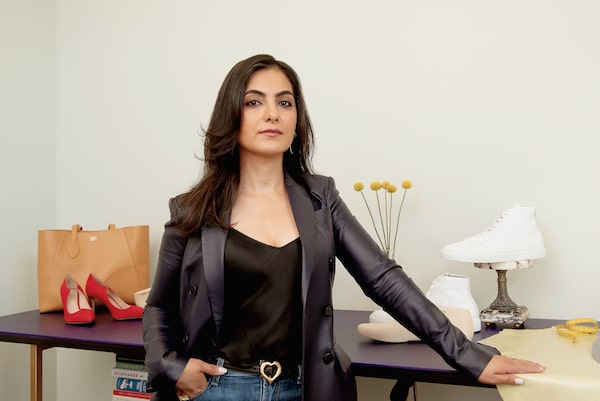
Elle AyoubZadeh, founder and creative director of Zvelle, prides herself on the quality of her products and service and has largely bootstrapped the company.Duane Cole/The Globe and Mail
Elle AyoubZadeh, founder of luxury handbag and shoe brand Zvelle, has a hand in nearly every aspect of the business – production at luxury factories in Italy, importing to Canada, and selling direct-to-consumer from here.
She prides herself on the quality of her products and service and has largely bootstrapped the company, aside from a $200,000 angel investment early on. So she was beyond stressed when 500 pairs of boots, retailing for $355 each, went missing in transit last year.
“It was scary,” said Ms. AyoubZadeh. The boots were sold on preorder, so she spent two weeks wondering how she’d please her customers if they never showed up, while also worrying about the money she’d invested. “They found them eventually but not without a lot of work on our end to get them back. And we paid more … to ship them out to customers to make up for the delay.”
The incident highlights the impacts of continued supply chain bottlenecks. Materials are harder to source, freight takes longer and is more expensive. It means that when a direct-to-consumer company like Zvelle is ready to export its goods, it has often faced several slowdowns or supply issues.
One of the company’s most popular products is its Ray high-top sneaker, a deer- and goatskin leather shoe that comes in black, white or navy, but is often sold out these days due in part to supply-chain issues such as sourcing the rubber and leather.
Ms. AyoubZadeh, who launched the company in 2015, has learned to be flexible with materials and will often alter a product slightly if a reasonable, high-quality alternative material is available within 100 kilometres of her factories.
“We’re buying skin that is already available and a by-product of the meat industry,” said Ms. AyoubZadeh, citing waste reduction as one of the key values of her business. She says the strategy also saves money because she’s not locked into a certain supplier, no matter the cost. It also means Zvelle’s products are made in small batches, limiting inventory overstock and the need to offer items on sale.
“My team laughs at me. I like a good sale myself [as a consumer]; I just don’t like putting my brand on sale,” she says.
Ms. AyoubZadeh says the company’s sales grew 20 per cent year-over-year during the pandemic, noting the growth has come despite increased shipping and fulfilment costs which she describes as “the biggest challenge right now.” Something that once cost $10 to ship is now about $30, she says, adding small businesses like hers can’t afford to absorb those higher fees.
Zvelle cut its retail prices to attract consumers during the start of the pandemic and was able to maintain those prices until recently. “We’re simply at a point where we can’t do it,” she says and plans to raise them in the short term.
Shipping speed has also decreased significantly, so her company sometimes pays more for air freight.
“We made less money but didn’t risk our products being stuck,” she says.
Reza Bafandeh, a Vancouver-based supply chain and logistics expert, says many freight delays result from the online shopping boom that started at the height of pandemic lockdowns. He says businesses buoyed by strong e-commerce made bigger-than-usual orders, and the shipping industry has struggled to keep up.
As demand eased, some steamship lines cancelled routes, increasing competition for the remaining container space and allowing the shippers to raise prices to compensate for the lost demand.
“During the height of the pandemic, it went from a few thousand [dollars] to $15,000 a container,” says Mr. Bafandeh, who worked in the grocery industry before taking the role of chief executive officer at the high-tech fulfilment company Darwynn in January.
He says many companies shipping from Europe to the east coast of Canada faced serious delays and chose to send their shipments to the west coast instead, which contributed to backlogs at ports there.
He says shipping in smaller batches is a good strategy, given the delays. Ordering too much, then facing a delay, can mean that when a company receives their goods, the demand has eased, leading to swaths of excess inventory.
“Putting more money into inventory limits your cash flow,” he says. “That can have huge impacts on a business.”